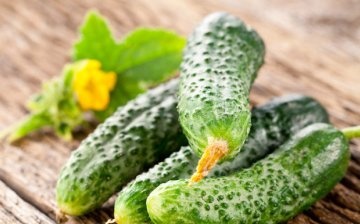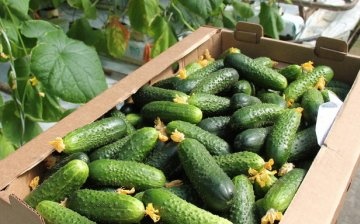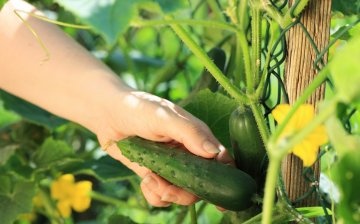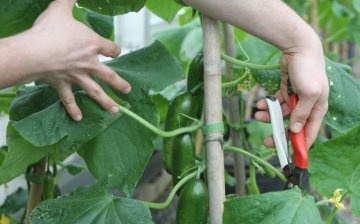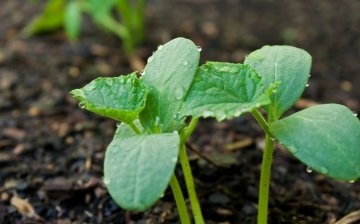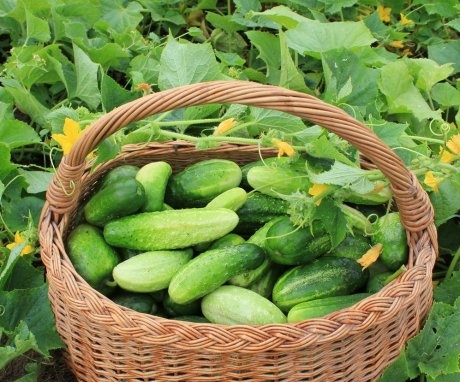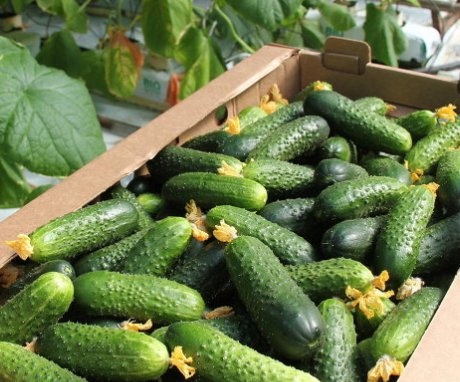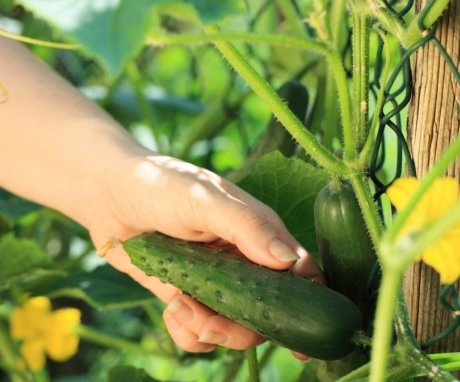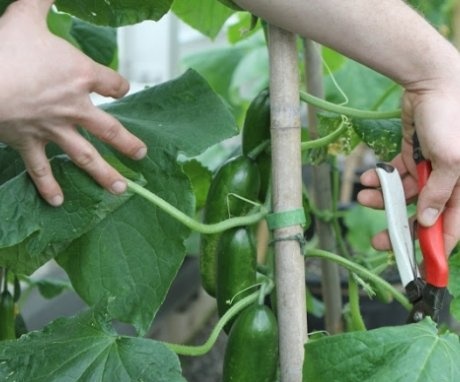Growing cucumbers: which variety is the most productive?
Cultivation of cucumbers is not difficult, and the quantitative indicators of the yield obtained do not always depend on the quality of care. It is important to correctly select varieties for cultivation in outdoor or greenhouse conditions. Also, many hybrids have been developed, suitable for any conditions and purposes of use.
Content
- The most productive varieties of cucumbers for open ground
- The most productive varieties of cucumbers for greenhouse conditions
- High-yielding hybrid varieties
- Tips for Increasing Your Cucumber Yield
- Competent preparation for planting cucumbers
The most productive varieties of cucumbers for open ground
Before choosing a specific variety cucumbers, you need to determine the place where they will be grown - in greenhouses or in the open air. Each variety has its own advantages: greenhouse ones provide fresh vegetables throughout the year, and ground ones are less demanding to care for. A good harvest can be achieved if you choose the right variety: it is better to grow self-pollinating varieties in greenhouses, because pollinators have limited access to flowers, especially in winter. And in outdoor conditions, several varieties should be planted so that the harvest is stable and does not depend on weather conditions.
For open ground:
- Delicacy. The variety is distinguished by early ripening and survives short-term frosts well. The fruits can be harvested for a long time. But planting should be carried out no thicker than 5 bushes per square meter. Cucumbers are medium-sized, oval-elongated, covered with a thin dark green skin with small pimples and are famous for their dense pulp with a high sugar content.
- The son of the regiment. Mini gherkins, the size of which does not exceed nine centimeters. The bushes branch weakly, the ripening period is average. During flowering, mainly female flowers are formed, therefore the variety is recommended for mixed plantings. The fruits have high taste characteristics, but if not harvested on time, they can outgrow and turn yellow. The fruiting period is long. The variety is versatile and resistant to common diseases.
- Corina. Early ripening high-yielding variety. The bushes are medium-sized and self-pollinating, therefore they can be cultivated both in the open air and in greenhouse conditions. The culture is distinguished by strong immunity to diseases. The optimal planting density is 3 specimens per m2. Fruits without bitterness in dense pulp, which gives cucumbers versatility. On the skin there are small bumps of a more intense color with whitish tips.
- Nezhinsky. It is a mid-season high-yielding variety resistant to diseases. Pollination takes place with the help of bees. Bushes have increased climbing ability. The ovate-oval fruits grow up to 16 cm long and weigh up to 110 grams.
- April. An early variety with large, elongated-oval fruits that reach 25 cm and do not taste bitter. Resistance to frost allows early planting in the ground, which will speed up the harvest.
- Erofei. A variety with bisexual flowers, but abundant harvests can be obtained by pollination by bees. Fruits are universal in use, medium-sized, up to 9 cm in length.The bushes are vigorous and resistant to powdery mildew.
The most productive varieties of cucumbers for greenhouse conditions
Cucumbers are represented by winter-spring, spring-summer or summer-autumn species. Also, varieties are distinguished by purpose: pickling, salad and universal. All groups have different periods of fruit setting and growth, as well as different pollination methods: with the help of insects and without the participation of those. But for most summer residents, the cultivation of universal varieties suitable for eating and rolling is of particular benefit and convenience.
The best varieties of cucumbers:
- Tumi. Cucumbers are hardy and undemanding to irrigation. They are resistant to disease. Temperature fluctuations are normal. The variety fell in love with gardeners for a high and stable yield. One bush is capable of producing 13-15 kg of cucumbers, small in size up to 10 cm and a thin dense skin.
- Courage... The most common variety among farmers, because it gives a rich harvest - up to 25 kg per plant. The number of fruits can be determined by the flowers: how many there are on the bush - so many cucumbers will be. True, for this you should follow all the rules of agricultural technology.
- Elegant. An early ripe variety that allows you to get the first harvest in a month and a half after planting. Bushes with medium lashes, resistant to spots and rot. The fruits are elliptical in shape with smooth and obtuse bases. The amount of harvest per square of area is up to ten kilograms.
- Tom Thumb. An early ripening high-yielding variety with female flowers. The variety owes its name to the size of the cucumbers, which does not exceed 12 cm. The plant itself is resistant to most diseases.
- Adam. The variety is early maturing and grown in various conditions. Fruits are dark green in color with light shortened stripes and indistinct spotting. Thin dense skin is densely covered with small tubercles. Cucumbers grow up to ten centimeters and weigh up to one hundred grams. The yield is good - more than 10 kg of fruit can be harvested from one square of the area.
High-yielding hybrid varieties
Today, hybrid varieties of cucumbers are becoming more and more popular, which are adapted for growing in greenhouse and outdoor conditions. They are more resistant to the effects of pathogenic conditions, have a more compact size and give abundant regular yields. The only drawback of hybrids is the lack of viable seeds, which makes it problematic to obtain seed at home.
The best varieties:
- German F1 is a high-yielding self-pollinating variety capable of producing over 25 kg of fruit per square meter. Cucumbers have high taste characteristics in fresh and canned form. The lack of bitterness in the taste makes vegetables ideal for preparing salads and reduces the preparation time before canning, since soaking is not required.
- Prestige F1 is an early over-yielding variety. Provided proper conditions are provided, about thirty kilograms of cucumbers per season can be harvested from one square of the area. The attractive appearance and taste of the fruit explains their popularity for canning. This hybrid is resistant to most diseases, temperature extremes and shading.
- Ekol F1 - is one of the best for salting. Cucumbers are medium-sized, crunchy, with dense and juicy pulp.
- Currently, the market has been captured by such foreign hybrid varieties as Nunems and Seminis, which are distinguished by very high yields.
- Chinese cucumber varieties are very aromatic, early ripening and high-yielding. Among them are the Chinese miracle, the early Chinese and Ji-Jo.
A feature of Indian hybrids is that the fruits can grow by seven centimeters per day and reach sizes up to two meters. Fruiting lasts until the very frost. Dutch varieties are capable of producing high yields, although they are not recommended for cultivation due to lack of taste.
Tips for Increasing Your Cucumber Yield
Cucumber crops are unpretentious, but certain efforts will have to be made to get a good harvest. To increase the yield of cucumbers, experienced gardeners share some secrets:
- root system cucumbers need to be maintained. For this, the stems are sprinkled with a layer of earth, which allows the plant to firmly establish itself in the ground.
- with a weak activity of pollinating insects, one should resort to artificial pollination. To do this, use a brush to transfer pollen from one flower to another.
- weekly, cucumbers should be fed with milk diluted with water in a 1: 2 ratio
- the culture belongs to the moisture-loving, therefore, the rules of watering should be observed. Irrigation is carried out in the early morning hours or in the afternoon, when the sun's activity subsides. In this case, care should be taken that water does not get on the leaves.
- need to be done regularly feeding... To increase productivity, the soil should be fertilized with peat, manure or rotted sawdust. And nitrogenous compounds during the fruiting period must be limited, because they stimulate the growth of greenery
- with regular loosening of the upper layer of the earth, the root system will receive a sufficient amount of oxygen, which will also affect the yield
Competent preparation for planting cucumbers
Experienced gardeners argue that yield largely depends on the organization of the preparatory procedures:
- Soil preparation and fertilization. For cucumber crops, sandy loam or slightly loamy soil with a neutral acidity level is suitable. The composition of the soil is brought back to normal by adding peat or sand, and the acidity is changed by adding lime, chalk or dolomite flour. In order for the cucumber bushes to give the expected yield, they should be well fertilized. In the fall, manure per site at the rate of 10 kg per m2 or superphosphate - 50 g per m2. In the spring, the introduction of partially rotted manure and ammonium nitrate is recommended - 20 g per m2. It is also advisable to add a little wood ash.
- Preparation and planting of seeds. Before planting, the seeds should be soaked to germination... This will speed up the development of the plant and weed out poor-quality seed. For these purposes, you can use ordinary warm water or stimulating solutions.
Sprouted seeds are planted in individual peat pots, which will preserve the integrity of the root system when transplanted to a permanent place. It is recommended to carry out the planting in the ground in stages, with an interval of 1-2 weeks. This trick allows you to extend the fruiting period of cucumbers.
After planting, the plant should be provided with regular watering and fertilization, and in return it will thank you with a good harvest.
With the right choice of variety, performing simple agrotechnical techniques and following the advice of experienced gardeners, everyone will be able to grow a good harvest. cucumbers on your site. By the way, planted in the neighborhood will help to protect the plant from attacks of pests. radish, garlic, cabbage or dill.
More information can be found in the video:



